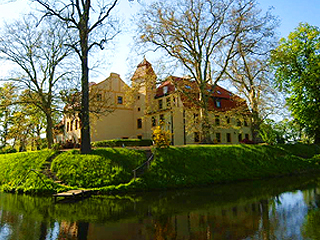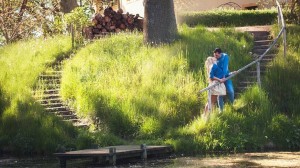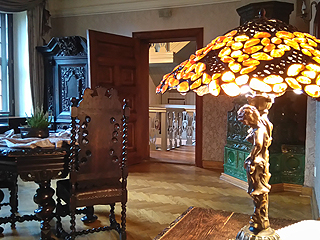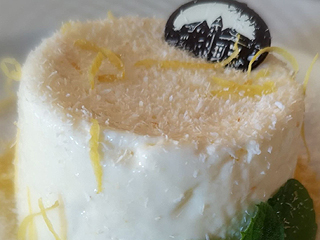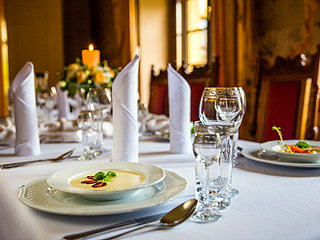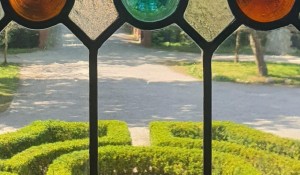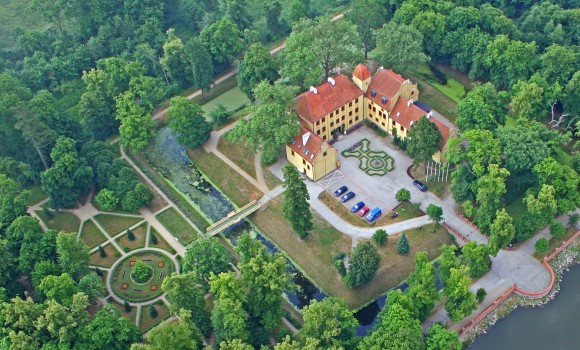The history of the castle and Krokowski / von Krockow family
Archivum Crocovianym
The part of the Krokowa Museum is the exhibition presenting history of family von Krokow, called Archivum Crocovianum. People visiting this place can find the information boards telling the history of some members of this family (e.g. Rajnold Krokoski, Ernest Krokowski I or the dark legend of Albert the Mad) and can also admire paintings, books and original documents from the past time of Krokowa.
History of family von Krokov
Krokowa is the settlement of one of the oldest Pomeranian noble family, whose ancestor “milites Gneomirus” appears in the documents already in 1285.
1288 i 1292: prince of Pomerania Mściwój II bestows the property of Jeldzino, Wysoka, Krokowa, Minkowice, Glinki on Gniewomir Crockau.
1300: The bishop of Wroclaw allows Peter Krokowski to build a new church in Krokowa, independent from Żarnowiec. Piotr Krokowski terribly disturbed during the masses in Żarnowiec and Cistercians Sisters asked bishop to build him a separate church!
1375-1407: The owner of Krokowa and Jeldzino is Knight Gniewomir, mentioned for the first time in 1375 as Gneomyrus domicellus Craccouie. As the man of great violence he does penance for killing his neighbour Michał Kunostowic from Sławoszyno in 1381-1382. His son is lost in 1399 r. during the expedition to Tartars. Teutonic Order pays the compensation to father.
1448: Knight Jerzy of Wikrowo, Chamberlain of Grand Master of the Teutonic Knights Conrad von Erlichshausen, becomes the owner of Krokowa lands after having married Catherine, daughter of the last heir of Krokowa. Jerzy of Wikrowo adopts the family name Krokowski.
1476-1501: The owner of Krokowa, famous for his strength, is Wawrzyniec (Lorke) “Kaszuba” Krokowski, son of Jerzy, courtier of Polish king Jan Olbracht. He expands dominions of his family by Roszczyce, Osieki and Salino. In 1493 he becomes king starost in Lębork. His brother Jerzy was an abbot of Monastery of Cistercians in Oliwa.
1516: Hans Krokowski, son of Wawrzyniec, is beheaded by Major of Gdansk Eberhard Ferber after the trial concerning seizure of properties in Salino. His head is exposed in front of the city walls.
1536-1599: The owner of Krokowa is Rajnold Krokowski, knight, army officer and diplomat – the greatest representative of the family. From 1547 in service of Henry II King of France, and from 1560 after coming back to Poland in service of Sigismund I the Old – King of Poland. He fights against Russians and Turkish. In 1569 he fights in France together with 1500 of his soldiers on Huguenots princes side. In recognition of his achievements he receives honourable title – marshal of France. As the result of sustained wounds he gives up fighting and dedicates himself to diplomacy. In reward for defending Puck from the attack of Brunswick prince he is given the brewery in Puck!
1602: Ernest Krokowski, son of Rajnold, becomes the father of the family Krokowski line. This line dies out in 1725 as Krzysztof Krokowski, the captain of Polish Army, passes away.
1772: First partition of Poland. Heir of Krokowa, regiment commander Kaspar Reinhold von Krockow, swears an oath of loyalty to Prussian Kings.
1782: Krokowa property is put up for compulsory auction. The bidders are the landrat of Tczew Caspar Ludwik von Below and the wife of Heinrich Joachim Reinhold von Krockow from house of Pieszcza. Auction is won by Louisa von Krockow who buys properties for 40 650 talars. Louisa rebuilds the palace and sets up a beautiful park, famous in the whole XVIIIth century Europe.
1786: King of Prussia Friedrich confers the title of count on members of all Krokowski house.
1791-1792: German philosopher Johann Gottlieb Fichte stays at Krokowa castle as a teacher of countess Louisa von Krockows children.
1803: after the death of his mother “mad graf” – Albert Kaspar Ewald von Krockow takes over the property of Krokowa. In 1807 he loses major part of the estate due to Prussian agricultural reform.
1823: The body of a “mad graf” lies on Lord’s Hill, together with his horse and dogs. Since then everyday around midnight graf rides his fiery steed with pack of dogs between Krokowa, Sławoszyno and Minkowice. Children are told not to stay outside, ‘because the mad graf comes and…’
1850: After seventeen years of work Neo-Gothic parish church is finished. The author of the project, builder and the chief constructor is count Karol Gustaw Adolph von Krockow, who takes and passes his bricklaying master exam mainly for that reason. The inspiration for the project is Notre Dame Cathedral.Until year 1945 the church remains Protestant, and the pastors salary is set by the family von Krockow.
1878: Five-year-old count Döring von Krockow becomes the last owner of the Krokowa property – in August 1945 he leaves his family lands not to return there any more.
1920: When Poland regained independence the von Krockows adopt Polish citizenship. Children take Matura Exam (Polish end of school exam) both in Polish and German.
1939: The Second World War breaks out- one of the Döring’s sons, Reinhold (1911) fights during the Polish September Campaign as a Polish officer, but dies as an officer of Wehrmacht (1944). His brothers Heinrich (1912-1944) and Ulrich (1922-1943) also die as German officers. Only Albrecht (1913) and Cecilia (1916) stay alive.
1945: The Castle is a seat for a National Agriculture Farm and other public institutions.
1990: Albrecht von Krockow and the then village mayor of Krokowa Kazimierz Plocke initiate the establishment of the European Meetings. Kashubian Culture Centre Foundation in Krokowa, which rebuilds the Castle and designates it for the rooms, restaurant and the museum.

